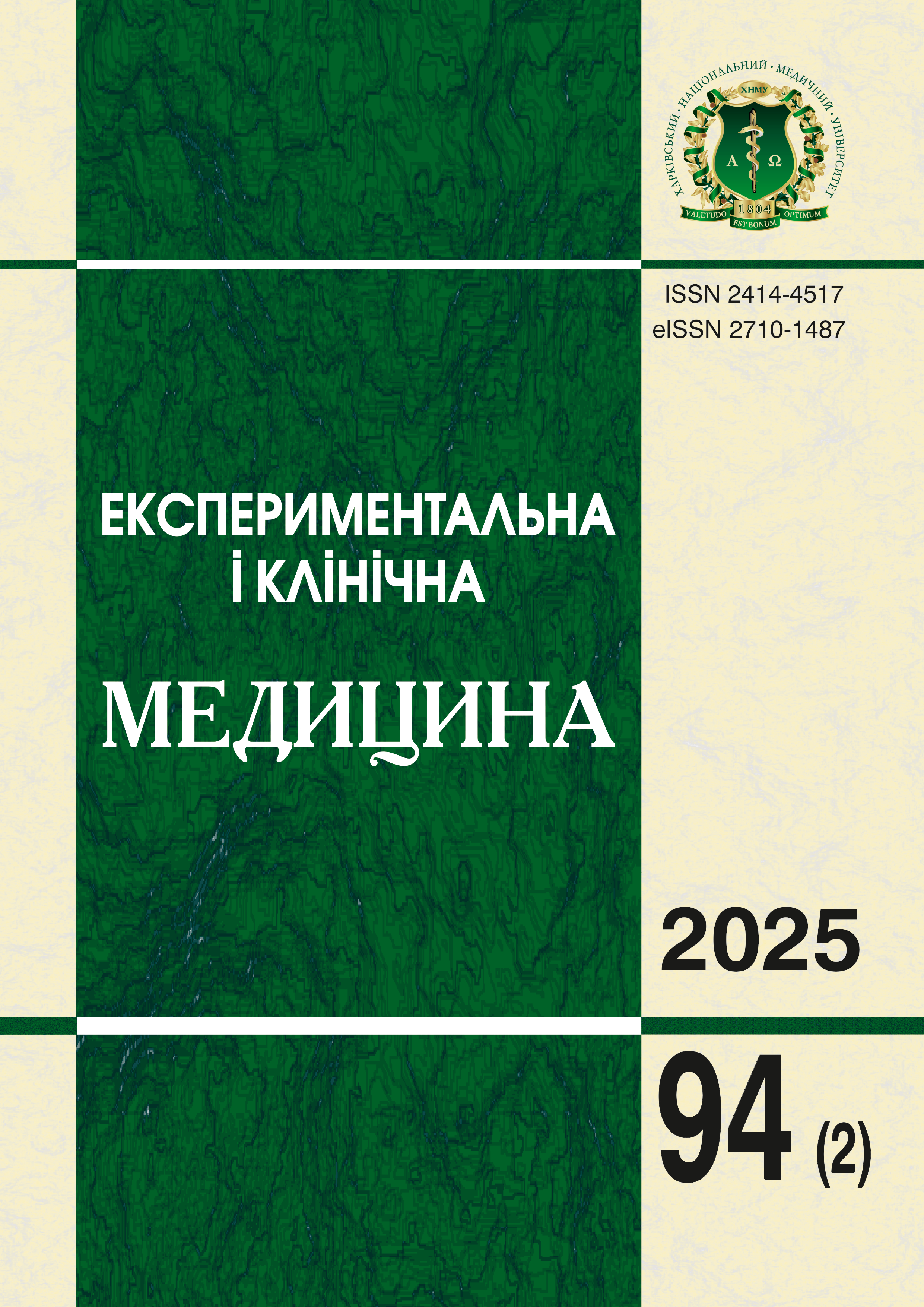Abstract
Papillary Thyroid Carcinoma (PTC), a well-differentiated malignant neoplasm originating from thyroid follicular cells, has been increasingly studied for its association with obesity. In Ukraine, PTC accounts for approximately [1.7–1.8]% of all malignant tumors. Accumulated evidence suggests that obesity, characterized by a Body Mass Index (BMI) over 30 kg/m2, promotes carcinogenesis through hormonal changes, chronic inflammation, oxidative stress, and insulin resistance. The aim of the study was to investigate the relationship of obesity or overweight with PTC size. This retrospective study examined 91 patients with histologically confirmed PTC, categorizing them based on BMI into normal weight, overweight, and obese groups. Patients were divided into groups in relation to their weight. The study group comprised patients with overweight and obesity based on their BMI. Informed consent was obtained from all participants. Statistica 12 (TIBCO Software Inc., USA) and GraphPad Prism 10 (GraphPad Software, LLC, USA) statistical software were used for data analyses. Statistical significance was set at p<0.05. The study showed that in our cohort, 71% of PTC patients were overweight or obese. Notably, larger tumors (≥1 cm) were more common in obese and overweight groups, whereas PTC microcarcinomas (<1 cm) were more frequent in patients with normal weight, suggesting a potential correlation between obesity and larger tumor size (p<0.05). This size differential suggests that metabolic factors associated with higher BMI may influence tumor growth in PTC. The results of the study indicate that PTC with a tumor diameter of ≥1 cm is more likely in obese and overweight patients. Thyroid microcarcinomas are more common in patients of normal weight. Obesity can be considered as a risk factor for faster growth of neoplasms in PTC.
Keywords: papillary thyroid microcarcinoma, cancer risk, body mass index, neoplasm staging, prognostic factors, morphometric parameters.
References
Dinets A, Gorobeiko M, Hoperia V, Lovin A, Tarasenko S. Papillary thyroid carcinoma coexisting with benign thyroid and parathyroid pathology: clinical and pathomorphological features. International Journal of Endocrinology (Ukraine). 2023;19(4):274-8. DOI: 10.22141/2224-0721.19.4.2023.1285.
Gorobeiko M, Zdorna V, Dinets A. Positive effect of vitamin D supplementation on weight loss in obese patients treated with glucagon-like peptide 1 and lifestyle interventions. International Journal of Endocrinology (Ukraine). 2022;18(5):278-84. DOI: 10.22141/2224-0721.18.5.2022.1186.
Celescuekci LG, Pinto MP, Botelho IMB, Pavin EJ, Zantut-Wittmann DE. Insulin resistance factors associated with differentiated thyroid carcinoma and malignant cytology: serum thy-roxine as an associated factor. Ann Med. 2025;57(1):2530697. DOI: 10.1080/07853890. 2025.2530697. PMID: 40662255.
Sparavelli R, Giannini R, Signorini F, Materazzi G, Basolo A, Santini F, et al. Papillary Thy-roid Carcinoma and Body Mass Index: The Role of Immune System in Tumor Microenvi-ronment. Int J Mol Sci. 2025;26(17):8290. DOI: 10.3390/ijms26178290. PMID: 40943211.
Vitale E, Rizzo A, Santa K, Jirillo E. Associations between "Cancer Risk", "Inflammation" and "Metabolic Syndrome": A Scoping Review. Biology (Basel). 2024;13(5):352. DOI: 10.3390/biology13050352. PMID: 38785834.
Kitana FI, Shobab L. The Interaction between Sex and Thyroid Cancer Development and Management. Endocrinol Metab Clin North Am. 2025;54(3):483-95. DOI: 10.1016/j.ecl.2025.03.016. PMID: 40716901.
Shumakov OV, Parkhomenko OM, Lutay YaM, Khomiakov DV. Diagnostic value of clinical-instrumental and hematological indicators in predicting complications of the hospital period of STEMI in conditions of chronic stress caused by wartime. Ukrainian Journal of Cardiology. 2024;31(1):34-45. DOI: 10.31928/2664-4479-2024.1.3445. [In Ukrainian].
Haglund F, Rosin G, Nilsson IL, Juhlin CC, Pernow Y, Norenstedt S, et al. Tumour nuclear oestrogen receptor beta 1 correlates inversely with parathyroid tumour weight. Endocr Connect. 2015;4(1):76-85. DOI: 10.1530/EC-14-0109. PMID: 25648860.
Song S, Leng Z, Zhao X, Liu Z, Li Y, Zhang W, et al. ASAP1 Promotes Epithelial to Mesenchymal Transition by Activating the TGFbeta Pathway in Papillary Thyroid Cancer. Cancer Med. 2025;14(15):e71075. DOI: 10.1002/cam4.71075. PMID: 40742091.
World Health Organization. Obesity: preventing and managing the global epidemic. Report of a WHO consultation. Geneva: WHO; 2000. 253 p. Available at: https://apps.who.int/iris/handle/10665/42330
Trimboli P, Bojunga J, Deandrea M, Frasca F, Imperiale A, Leoncini A, et al. Reappraising the role of thyroid scintigraphy in the era of TIRADS: A clinically-oriented viewpoint. Endocrine. 2024;85(3):1035-40. doi: 10.1007/s12020-024-03825-0. PMID: 38625504.
Juhlin CC, Baloch ZW. The 3rd Edition of Bethesda System for Reporting Thyroid Cytopathology: Highlights and Comments. Endocr Pathol. 2024;35(1):77-9. DOI: 10.1007/s12022-023-09795-9. PMID: 38032439.
Haugen BR, Alexander EK, Bible KC, Doherty GM, Mandel SJ, Nikiforov YE, et al. 2015 American Thyroid Association Management Guidelines for Adult Patients with Thyroid Nodules and Differentiated Thyroid Cancer: The American Thyroid Association Guidelines Task Force on Thyroid Nodules and Differentiated Thyroid Cancer. Thyroid. 2016;26(1):1-133. DOI: 10.1089/thy.2015.0020. PMID: 26462967.
Lloyd R, Osamura R, Klöppel G. Other encapsulated follicular-patterned thyroid tumours. Classification of tumours of endocrine organs. 4th ed. Lyon, France: World Health Organiza-tion; 2017. 355 p. Available at: https://is.gd/4PaKWL
Matson J, Bouvet M. Use of fluorescence image-guided surgery and autofluorescence in thyroid and parathyroid surgery. Mini-invasive Surg. 2023;7:10. DOI: 10.20517/2574-1225.2022.81.
Thomsen RW, Mailhac A, Løhde JB, Pottegård A. Real-world evidence on the utilization, clinical and comparative effectiveness, and adverse effects of newer GLP-1RA-based weight-loss therapies. Diabetes Obes Metab. 2025;27_Suppl 2(Suppl_2):66-88. DOI: 10.1111/dom.16364. PMID: 40196933.
Haglund F, Juhlin CC, Brown T, Ghaderi M, Liu T, Stenman A, et al. TERT promoter mutations are rare in parathyroid tumors. Endocr Relat Cancer. 2015;22(3):L9-11. DOI: 10.1530/ERC-15-0121. PMID: 25876648.
Suliman A, Mohamedosman R, Soud M, Suliman H. An atypical metastatic pathway: Bilateral inguinal lymphadenopathy as the initial presentation of papillary thyroid carcinoma. Int J Surg Case Rep. 2025;129:111189. DOI: 10.1016/j.ijscr.2025.111189. PMID: 40158358.
Rossi ED, Agarwal S, Erkilic S, Hang JF, Jalaly JB, Khanafshar E, et al. Psammoma bodies in thyroid: are they always indicative of malignancy? A multi-institutional study. Virchows Arch. 2024. DOI: 10.1007/s00428-024-03934-1. PMID: 39349665.
Song RY, Kim HS, Kang KH. Minimal extrathyroidal extension is associated with lymph node metastasis in single papillary thyroid microcarcinoma: a retrospective analysis of 814 patients. World J Surg Oncol. 2022;20(1):170. DOI: 10.1186/s12957-022-02629-8. PMID: 35643530.
Walgama E, Sacks WL, Ho AS. Papillary thyroid microcarcinoma: optimal management versus overtreatment. Curr Opin Oncol. 2020;32(1):1-6. DOI: 10.1097/CCO.0000000000000595. PMID: 31633497.

This work is licensed under a Creative Commons Attribution-NonCommercial-ShareAlike 4.0 International License.

